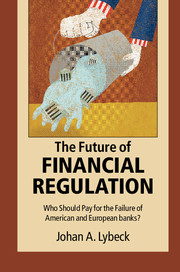Book contents
- Frontmatter
- Dedication
- Contents
- List of figures
- List of tables
- List of boxes
- Preface
- Acknowledgements
- List of abbreviations
- Introduction
- Part I A chronological presentation of crisis events January 2007 – December 2014
- Part II Bail-out and/or bail-in of banks in Europe: a country-by-country event study on those European countries which did not receive outside support
- Part III Bail-out and/or bail-in of banks in Europe: a country-by-country event study on those European countries which received IMF/EU support
- Part IV The TARP program and the bailing out (and bailing in) of US banks
- Part V Summary of the micro studies
- Part VI Political and regulatory responses to the crisis: to bail out or to bail in, that's the question
- Conclusion: toward host-country supervision and resolution?
- Addendum
- Bibliography
- Index
Part I - A chronological presentation of crisis events January 2007 – December 2014
Published online by Cambridge University Press: 05 February 2016
- Frontmatter
- Dedication
- Contents
- List of figures
- List of tables
- List of boxes
- Preface
- Acknowledgements
- List of abbreviations
- Introduction
- Part I A chronological presentation of crisis events January 2007 – December 2014
- Part II Bail-out and/or bail-in of banks in Europe: a country-by-country event study on those European countries which did not receive outside support
- Part III Bail-out and/or bail-in of banks in Europe: a country-by-country event study on those European countries which received IMF/EU support
- Part IV The TARP program and the bailing out (and bailing in) of US banks
- Part V Summary of the micro studies
- Part VI Political and regulatory responses to the crisis: to bail out or to bail in, that's the question
- Conclusion: toward host-country supervision and resolution?
- Addendum
- Bibliography
- Index
Summary
There exist already some 300 books and even more articles on the financial crisis, its causes and remedies; there is no need to add one more. Many of them are quoted in the list of literature at the end of the book. Especially recommended is the comparison and evaluation of some of the better ones by MIT Professor Andy Lo. Hence this part of the book makes no pretence at explanations; it gives a hopefully neutral and chronological description of events.
The Liikanen report contains a very useful summary of the “waves” following one after the other (p. 18):
• Wave 1: “Subprime crisis phase” (mid 2007 to September 2008): investment portfolios collapse (especially in MBSs and CDOs linked to subprime loans);
• Wave 2: “Systemic crisis phase” (from September 2008): unprecedented state aid to the banking sector is required as liquidity evaporates;
• Wave 3: “Economic crisis phase” (from 2009): automatic stabilizers kick in following the recession, and fiscal sustainability is imperiled through fiscal stimulus and state aid;
• Wave 4: “Sovereign crisis phase” (from 2010): bank–sovereign feedback loops raise significant challenges given the existing institutional EU framework;
• Wave 5: “Crisis of confidence in Europe phase” (from 2011 and present): EU at a crossroads.
These “waves” should be borne in mind while reading the timeline below.
5 February 2007: The mortgage bank Mortgage Lenders Network, the fifteenth largest subprime lender in the United States, becomes the first victim of the subprime crisis when it files for Chapter 11 protection.
7 February 2007: The British megabank HSBC announces a new reservation of 1.8 billion dollars for potential losses in its portfolio of US subprime loans; its head of US mortgage banking is fired.
27 February 2007: The semi-government owned mortgage bank Freddie Mac announces that it will no longer purchase (and securitize) subprime mortgages.
28 March 2007: Treasury Secretary Hank Paulson appears before a committee of the House of Representatives, saying that “From the standpoint of the overall economy, my bottom line is we're watching it closely but it appears to be contained.”
2 April 2007: New Century Financial, the second largest subprime lender in the US, files for protection under Chapter 11.
- Type
- Chapter
- Information
- The Future of Financial RegulationWho Should Pay for the Failure of American and European Banks?, pp. 1 - 142Publisher: Cambridge University PressPrint publication year: 2016



